Reviews
I Kinighi
Theodoros Angelopoulos
Greece, 1977
Credits
Review by Ian Johnston
Posted on 12 November 2012
Source Artificial Eye DVD
Categories Taking Time: The Cinema of Theodoros Angelopoulos
This is a terribly sad film, an unpleasant film that rejects all relief stemming from easy hopes. It is a film about the present we live in, about how things seem to stay the same as if nothing had happened despite all the political changes taking place around us.1
The Hunters was Angelopoulos’ follow-up to Cannes prize-winner The Travelling Players, which saw him in a position of double freedom. Critical acclaim gave him the confidence to develop further his political themes and his aesthetic of the lengthy moving sequence shot in which chronology shifts from one time period to another. And the military junta ruling Greece from 1967 had come to an end (mid-way through the making of The Travelling Players, in fact), allowing him to directly address recent political events. In the case of the latter it’s perhaps ironic that on the level of the historical/political events being portrayed The Hunters ended up as Angelopoulos’ most hermetic and obscurantist work.
Which is not to say that the film’s basic premise is hard to follow. A group of hunters in the present day (1976) uncover in the snow the perfectly preserved corpse of a Communist fighter killed at the end of the Civil War in 1949. The hunters - all Rightists who have prospered under the anti-Left political climate that followed the defeat of the Communist Democratic Army of Greece - carry the corpse back to a hotel; laid out on a table, with (as is repeatedly noted) “the blood of the wound […] still fresh as if he was alive,” the corpse in its very presence exposes the guilty conscience of these Rightists, whose deeds are condemned in both political and moral terms.
A kind of inquest/police investigation is carried out around the laid-out corpse and the Rightists give individual testimony, in this way ranging over Greek history since the Second World War. Specific dates are referenced, although the film itself only makes vague allusions to each date’s significance:
- 1958: elections were won by the United Democratic Left party, whose deputy was assassinated in 1963 and which was outlawed by the military junta in 1967
- 12 February 1946 / 12 February 1949: representing the years of the Civil War
- 29 August 1949: considered the date of the collapse of the Democratic Army of Greece
- 22 May 1963: the fatal attack on United Democratic Left deputy Grigoris Lambrakis
- 16 February 1964: the electoral victory of Giorgios Papandreou and his Centre Union party, supported by the Left
- 15 July 1965: the “Royal Coup” centred around Papandreou’s resignation May 1967: the scheduled date for elections that were prevented by the April 21 coup d’état.
(I’ve provided here more details than the film’s dialogue does.)
We’re dealing here with the minutiae of electoral politics, but with the common theme of the Right’s undermining of the democratic process, and with a narrative that ranges over a wide number of years. Already in The Travelling Players Angelopoulos had developed a strategy of segueing within a single scene from one time period to another. In that film’s opening sequence the camera tracks backwards before the players as they walk down the street on the eve of the 1952 elections; a 180° cut then follows them into a square while a tannoy announcement cues us to the time having shifted to more than ten years before. As the film progresses, this time segue is increasingly effected within the one sequence shot: for example, a pan down the street to the right following an electioneering van in 1952 pans back to the left with a passing car to reveal the town now under German occupation during the Second World War.
Now, consider how much more complex Angelopoulos makes this stylistic trope in The Hunters, with this one example: two men walk along a beach together, briefly kick an invisible football between them (the chimera of the revolution?) and engage in an obscure dialogue exchange. One man has already been identified to us as the Communists’ local political indoctrinator; the other will only be later named: Giorgios Fantakis, an apostate from the Communist cause who betrays his prison comrades. Here, the shift in time period occurs literally between one line of dialogue and the next, when Fantakis’ “As of yesterday, 29 August 1949, it’s finished” is answered by Diamantis’ “Today it’s 22 May 1963.” This compression of the time shifts is indicative of the sheer density of what Angelopoulos is doing in The Hunters. He’s proposing his own version of Brechtian epic theatre, where a hotel reception hall becomes the stage setting for a cast that are more “types” - a colonel, a businessman, an ex-prefect of police turned publisher, an ex-partisan turned wealthy contractor, a politician, a film actress, a royalist noblewoman2 - than rounded characters for us to empathise with.
Empathy is the last thing Angelopoulos wants from us. There’s a deliberate coldness to these paper-thin figures, most of whom are not even identified by name, for we’re being asked to cast a distanced, critical eye on this entire political-social class. Angelopoulos himself has called The Hunters a “cold” film like Days of ‘36,3 and as with that film satire is used to underline the critique. There’s even one early shot, of a corridor in the hotel, which is played like some kind of Feydeau farce with doors being opened and closed, characters racing from one door to the other, and even one of the hunters trying to sneak out with his packed bags before being caught by Savas, the most brutal of his companions.
Each figure, in giving his or own testimony to the investigating police officials, becomes a performer to the audience formed by the others. This is literalised in one of Fantakis’ scenes: the conflicted, guilt-ridden ex-partisan (the closest we have to any psychology or character depth in any of these figures) breaks off his love-making, impotent, and the camera pans with his gaze over to his fellow Rightists, standing to the side watching him. Yet, as this single take continues we realise we are in a different time (moving from 1964 to 1976) and space (the hotel reception hall again), and the roles of audience and performer shift yet again: the Rightists, seated around the dinner table, perform a song for us; then they fall silent as they observe a wealthy American woman sweeping around the room; and finally they’re the audience to one of their number, the politician, who is forced by the police officials to partially strip, don a dressing gown, be confronted with the body of the dead partisan (the audience of Rightists here briefly becomes actors shifting the props around), and - it seems - play the historical role of Papandreou resigning in 1965.
Ritualised actions, song, and dance are all welded together in a complex and sometimes opaque web of scenes and locales from recent (for the time) Greek history. And it is through song that Angelopoulos underlines the Rightists’ moral defeat. At the hotel the Rightists circle the partisan’s corpse, joining in their own variation on a song that has already been chanted by the military as they impose terror on the town in Angelopoulos’ own dramatisation of the ‘67 coup: Behind us we have a regime / That the centuries support / Fatherland, family, religion, and salary / Are immortal pillars / Everything else is transient / We write history ourselves. But when they move outside to the water’s edge the song fades from their lips as they are confronted by an image of the Left: red flags held aloft from a mass of small boats gliding smoothly across the water. A single voice, both lyrical and mournful, floats through the air, a rebuke to the triumphant militarism of these bourgeois, and the camera tracks back to show them with their backs to us, lined up horizontally across the frame, facing the Left and reduced to utter silence.
This water’s edge is the scene, too, of their symbolic execution when their 1977 New Year’s party is interrupted by an incursion of partisans (this, after the hotel band and all the other guests have vanished in the process of Angelopoulos’ sinuous track) and the emergence of the dead partisan from his hiding place behind the curtain. Two planimetric4 lines confront one another: the partisans against the background of the hotel as the “2nd Mobile Rebel Court of the Democratic Army” passes sentence on 29 August 1949;5 and, on the other side of a 180° pan, the Rightists against the lake, falling under the fire of their execution. A cut back to the ‘77 New Year’s party has the Rightists frozen just as they were before the boats of the Left, here traumatised by this monster rising up from their collective Id—which is, after all, what is represented by the corpse of the partisan. Their hurried reburial of that corpse merely underlines their denial, their wilful repression of the historical record and their own role in it; and the futility of this is made clear in the film’s final shot of these figures as they become progressively smaller and smaller, disappearing into an expanse of empty white snow.
- Francesco Casetti, “Rhythms of Silence to Better Underline the Screams: The Hunters,” in Dan Fainaru, ed. Theo Angelopoulos: Interviews, Jackson: University Press of Mississippi, 2001, p. 25. ↩
- This description is courtesy of the Angelopoulos website: http://www.theoangelopoulos.com/hunters.htm. It’s impossible to identify all of these figures from the film alone. ↩
- Fainaru, p. 26. ↩
- The word Bordwell uses to describe Angelopoulos’ staging of a horizontal line of figures across the frame: David Bordwell, “Modernism, Minimalism, Melancholy: Angelopoulos and Visual Style,” in Andrew Horton, ed. The Last Modernist: The Films of Theo Angelopoulos, Westport: Praeger, 1997, p. 20. ↩
- This date, remember, represents the defeat of the Democratic Army. ↩
More Taking Time: The Cinema of Theodoros Angelopoulos
-
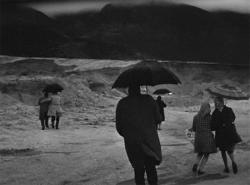
Reconstruction
1970 -
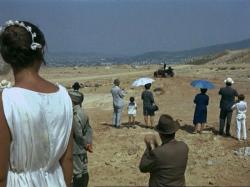
Days of ‘36
1972 -
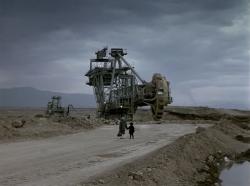
Landscape in the Mist
1988 -
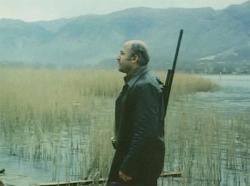
The Hunters
1977 -
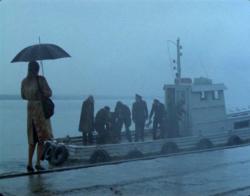
Voyage to Cythera
1983
We don’t do comments anymore, but you may contact us here or find us on Twitter or Facebook.



